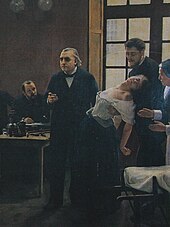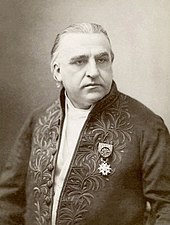Jean-Martin Charcot
Jean-Martin Charcot (born November 29, 1825 in Paris , † August 16, 1893 in Montsauche-les-Settons on Lac des Settons / Département Nièvre in the Morvan ) was a French pathologist and neurologist . He is one of the most important doctors in the history of the Hôpital de la Salpêtrière . In 1882 he established the first independent neurological department in Europe there. Together with Guillaume-Benjamin Duchenne , he is considered the founder of modern neurology . The polar explorer Jean-Baptiste Charcot was his son.
Life

After completing his medical studies at the Sorbonne in 1853 with a doctoral thesis on various forms of rheumatoid arthritis, Charcot initially owned a private practice and from 1848 as a hospital doctor at the Salpêtrière , where he became chief physician in 1862. In 1872 he became a full professor of pathological anatomy at the University of Paris , where he published numerous papers on the anatomy and pathology of the nervous system . In 1882, the world's first chair for diseases of the nervous system was established for Charcot at the Hôpital de la Salpêtrière in Paris.
In 1883 Charcot was accepted into the Académie des Sciences . From 1888 to 1889 he published his famous Leçons du mardi , in which he demonstrated clinical cases to an international audience of doctors, journalists and writers.
Hardly any other scientist of the 19th century had such a lasting influence on the development of neurology as Charcot. In the second half of the 19th century he made important discoveries in almost all areas of neurology. He was the first to describe amyotrophic lateral sclerosis and neurogenic arthropathy . He also distinguished multiple sclerosis and Parkinson's disease as separate clinical pictures from each other.
On June 7, 1884, Charcot's assistant Raymond Combret, a member of the Theosophical Society in Paris , met with Henry Steel Olcott of the Theosophical Society in the Salpêtrière. In his later years, Charcot carried out mostly psychopathological studies on hysteria . Although some of his results were later revised, they had a major influence on the development of psychiatry and on the psychoanalysis of his student Sigmund Freud . It was Charcot's clinical use of hypnosis in an attempt to discover an organic cause of the hysteria that aroused Freud's interest in the psychological causes of the neuroses .
From August 1885 Freud studied with Charcot at the Salpêtrière. While he later successfully established his creation, psychoanalysis, as an independent science, it is often forgotten that it began with Charcot's study of hypnosis. Other research by Charcot on altered states of consciousness caused by hypnotic trance produced other disciplines that were less in keeping with the materialistic zeitgeist than that of Freud. Freud translated two books by Charcot and provided them with critical comments.
Charcot was a representative of the dominant science of the 19th century, which had come to terms with hypnosis, and tried to find a neurophysiological explanation for the symptoms he observed. He sought a purely materialistic explanation with which people who could be easily hypnotized could be viewed as mentally ill and with which one could strictly classify the successive stages of hypnosis. It was not until 1884 that his hypotheses were questioned by Hippolyte Bernheim and Ambroise-Auguste Liébeault , who put forward the theory that the hypnotic state is brought about by suggestion , which was finally proven in Liébeault's medical practice. It turns out that Charcot's belief that hypnosis had disease-related causes stemmed from the fact that he happened to work predominantly with hysterics at the Salpêtrière. Charcot admitted his defeat a few months before his death by stating in an article that hysterics are, in principle, easily subject to suggestion.
Charcot died after 1893 in an attack of angina pectoris .
Jean-Martin Charcot, a physician who had been artistically gifted and interested in art since his youth, collected historical representations of hysteria. He also introduced photography as a method of clinical documentation on the one hand and as a didactic method in lessons (projection of slides) on the other.
Charcot's work is described in detail by Axel Munthe in The Book of San Michele . A detailed account of Charcot can also be found in Henri F. Ellenberger's standard work The Discovery of the Unconscious: History and Development of Dynamic Psychiatry from its Beginnings to Janet, Freud, Adler and Jung .
Other famous students of Charcot were Georges Gilles de la Tourette , Joseph Babinski , Gheorghe Marinescu , Pierre Janet and Charles-Joseph Bouchard .
Terms and diseases named after Charcot
- Charcot's disease / Charcot's disease: amyotrophic lateral sclerosis, but occasionally also related to multiple sclerosis.
- Charcot-Marie-Tooth's disease : Hereditary motor-sensitive neuropathy (HMSN), which today are subdivided according to the various forms.
- Erb-Charcot syndrome : (Syphilitic or spinal paralysis ), originallyobserved in peoplewith syphilis .
-
Charcot triad:
- Charcot's triad I in neurology is a symptom combination of intention tremor , chanting language and nystagmus in cerebellar syndrome and multiple sclerosis.
- Charcot-Trias II in internal medicine describes a combination of symptoms of upper abdominal pain on the right, fever and jaundice in purulent cholangitis .
- Charcot dizziness: syncope or dizziness caused by a coughing fit and associated with a laryngeal spasm .
- Charcot-Bouchard aneurysm: Small cerebral aneurysms as a possible cause of intracerebral bleeding.
- Charcot-Joffroy Syndrome: Thrombophlebitis of the meningoarachnoid veins with pachy meningitis , also known as Spiller's syndrome.
- Charcot points / zones: Points at which pressure can trigger a hysterical crisis.
- Charcot Leyden crystals: colorless, pointed octahedral crystals in the sputum of asthma sufferers .
- Charcot's Syndrome: intermittent claudication ( intermittent claudication ).
- Charcot joint: neurogenic arthropathy .
- Charcot's foot : diabetic disease in which degeneration processes occur in the foot. This often fractures several times unnoticed and ossifies in a misalignment. These processes take place asymptomatically due to the polyneuropathy.
Charcot also coined the term in 1886 hystérie Grande to the misleading HysteRo epilepsy to avoid. His son Jean-Baptiste named the Charcot Island he discovered and Port Charcot in Antarctica after his father.
Charcot in the film
The French feature film Augustine (2012) directed by Alice Winocour shows Vincent Lindon in the role of the doctor.
literature
- Wanda Bannour: Jean-Martin Charcot et l'hystérie . Paris 1992.
- Hippolyte Bernheim : Hypnotisme et suggestion: Doctrine de la Salpêtrière et doctrine de Nancy . In: Le Temps . January 29, 1891.
- Jean Bogousslavsky (Ed.): Following Charcot. A Forgotten History of Neurology and Psychiatry. Basel 2011.
- Georges Didi-Huberman : The Invention of Hysteria. Jean-Martin Charcot's photographic clinic. Fink, Paderborn 1997, ISBN 3-7705-3148-5 (French first edition 1982).
- Marcel Gauchet, Gladys Swain: Le vrai Charcot: les chemins imprévus de l'inconscient . Paris 1997.
- Georges Guillain : Jean-Martin Charcot (1825-1893). Sa vie, son oeuvre . Paris 1955.
- Arup KR Kundu: Charcot in Medical Eponyms. In: The Journal of the Association of Physicians of India (JAPI). Volume 52, September 2004, pp. 716-718.
- Andreas Mayer : Microscopy of the Psyche. The beginnings of psychoanalysis in the hypnosis laboratory . Göttingen 2002.
- Paul Richer: Études cliniques sur la grande hystérie ou hystéro-épilepsie . Paris 1885.
- Barbara I. Tshisuaka: Charcot, Jean Martin. In: Werner E. Gerabek , Bernhard D. Haage, Gundolf Keil , Wolfgang Wegner (eds.): Enzyklopädie Medizingeschichte. De Gruyter, Berlin / New York 2005, ISBN 3-11-015714-4 , p. 237 f.
- Jean Thuillier: Monsieur Charcot de la Salpêtrière . Paris 1993.
- Gilles de la Tourette , Georges Albert Édouard Brutus: Traité clinique et thérapeutique de l'hystérie d'après l'enseignement de la Salpêtrière . Préface de Jean-Martin Charcot. Paris, 1891ff.
Web links
- Literature by and about Jean-Martin Charcot in the catalog of the German National Library
- Fabienne Hurst: Bizarre research: Showtime in the mental hospital in Spiegel Online : One day .
- Robin Pape: Biography of Jean Martin Charcot In: Biographical Archive of Psychiatry (BIAPSY) , 2015.
Individual evidence
- ^ Jean-Martin Charcot: Etudes pour servir à l'affection décrite sous les noms de goutte asthénique primitive, nodosités des jointures, rhumatisme articulaire chronique. 1853
- ↑ Barbara I. Tshisuaka: Charcot, Jean Martin. 2005, p. 237.
- ↑ a b James Webb : The Age of the Irrational. Politics, Culture & Occultism in the 20th Century. Marix, Wiesbaden 2008, ISBN 978-3-86539-152-0 , p. 411.
- ↑ a b Helmut Siefert : Jean-Martin Charcot , in: Wolfgang U. Eckart and Christoph Gradmann (eds.): Ärztelexikon. From antiquity to the 20th century , 1st edition 1995 CH Beck Munich pp. 93 + 94, medical dictionary. From antiquity to the present , 2nd edition 2001, pp. 76–78, 3rd edition 2006 Springer Verlag Heidelberg, Berlin, New York pp. 79–81. doi : 10.1007 / 978-3-540-29585-3 .
- ↑ James Webb: The Age of the Irrational. Politics, Culture & Occultism in the 20th Century. Marix, Wiesbaden 2008, ISBN 978-3-86539-152-0 , pp. 409-410.
- ^ Günter Krämer : Small Lexicon of Epileptology . Stuttgart: Georg Thieme, 2005. (p. 121)
- ↑ Augustine in the Internet Movie Database (English)
| personal data | |
|---|---|
| SURNAME | Charcot, Jean-Martin |
| BRIEF DESCRIPTION | French neurologist |
| DATE OF BIRTH | November 29, 1825 |
| PLACE OF BIRTH | Paris |
| DATE OF DEATH | August 16, 1893 |
| Place of death | Morvan |

